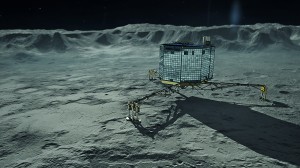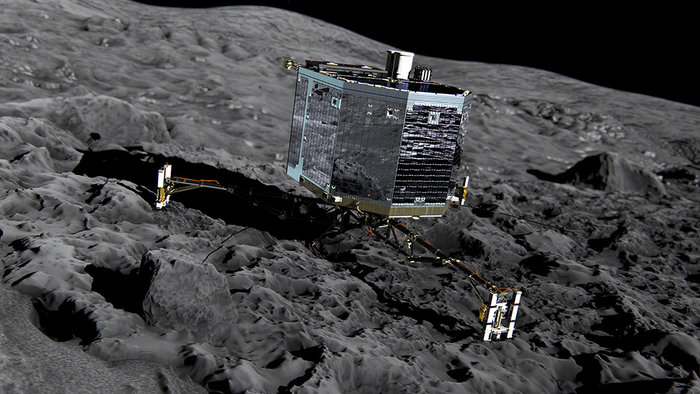Philae Phones Home
Thursday, June 18th, 2015June 18, 2015
Scientists were thrilled last weekend when the comet lander Philae awoke from a 7-month-long hibernation and contacted scientists on Earth. The lander is part of the Rosetta mission launched by the European Space Agency (ESA) to study comet 67P/Churyumov-Gerasimenko.

An artist’s illustration of Philae on Comet 67P/Churyumov-Gerasimenko. (Credit: DLR German Aerospace Center)
Rosetta is the first space probe to go into orbit around a comet. The ESA launched Rosetta on March 2, 2004, and it arrived at comet 67P in August 2014. Scientists believe that comets preserve dust, ice, and rock from the solar system’s formation. By closely studying the comet, they hope to learn more about the solar system’s makeup and history.
Rosetta carried instruments to study the comet from orbit, but it also carried a small lander named Philae. The lander touched down on the surface of the nucleus on Nov. 12, 2014. Philae was equipped with harpoons that should have anchored it to the comet’s surface. However, the landing failed to trigger the anchors, and the lander rebounded an estimated 0.6 mile (1 kilometer) above the comet’s surface. Philae returned to the comet and bounced one more time before settling in a heavily shaded area. Without sunlight on its solar panels, it could not recharge its batteries. Thus, the lander could only make observations and take readings for about 2 1/2 days before its batteries were depleted.
As 67P moved closer to the sun, more sunlight fell on Philae’s solar panels. The extra light gave the craft enough energy to contact Earth through the Rosetta orbiter on Sunday. The contact was brief, however—only 85 seconds long. ESA scientists are hoping contact can be sustained as the lander receives more energy from the sun.
Other World Book articles:



